Thailand Issues Rules for Government-Backed Digital Bond Token
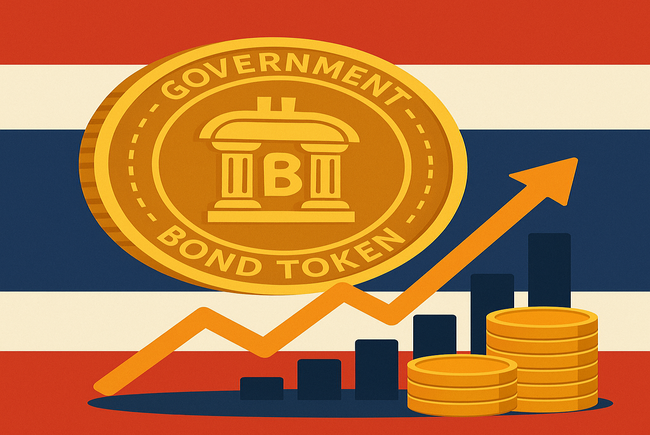
Thailand’s Securities and Exchange Commission (SEC) has introduced regulations for a new government-issued digital token, G-Token, which will be used to raise funds to address the country’s budget shortfall. The offering, scheduled to commence on July 25, will be conducted through an authorized initial coin offering portal, with the Ministry of Finance serving as the registrar. The SEC announced the regulatory framework on May 13, outlining the token’s function and limitations. While the G-Token is classified as a tokenized real-world asset, it cannot be used for payments or traded like traditional cryptocurrencies, the regulator said. The restrictions aim to ensure the token’s use remains within the scope of government fundraising rather than open market speculation. Fundraising Tool, Not Currency According to the SEC, the primary function of the G-Token is to facilitate direct public investment in state borrowing initiatives. The token represents a form of digital debt instrument backed by the Thai government, designed to raise capital for public spending needs. Authorities emphasized that the G-Token does not possess the characteristics of digital currencies. It will not be accepted as legal tender nor traded on cryptocurrency exchanges. These limitations aim to maintain regulatory oversight, distinguishing the asset from volatile digital coins. The offering will raise approximately $150 million, with specific terms — including maturity, interest rates and collateral — to be detailed closer to the launch date. The Ministry of Finance will oversee the registration and compliance processes. Part of Broader Digital Asset Strategy The G-Token initiative reflects the Thai government’s cautious approach to incorporating blockchain-based instruments in public finance. While embracing certain digital innovations, officials have maintained strict regulatory controls regarding retail investor protection and market stability. Thailand has previously implemented measures to govern digital asset businesses, including licensing requirements and consumer risk disclosures. The G-Token marks one of the first instances where the state is directly involved in issuing a blockchain-based fundraising tool under its authority. The SEC has not indicated whether similar tokens may be used in future offerings or expanded to other sectors. However, the outcome of the initial launch may influence how digital financial instruments are integrated into the country’s broader fiscal strategy. Financial analysts and regional regulators are closely monitoring the G-Token project, as it may serve as a model for other governments exploring tokenized public debt instruments.
What Are Yield-Bearing Stablecoins and How Do They Work?
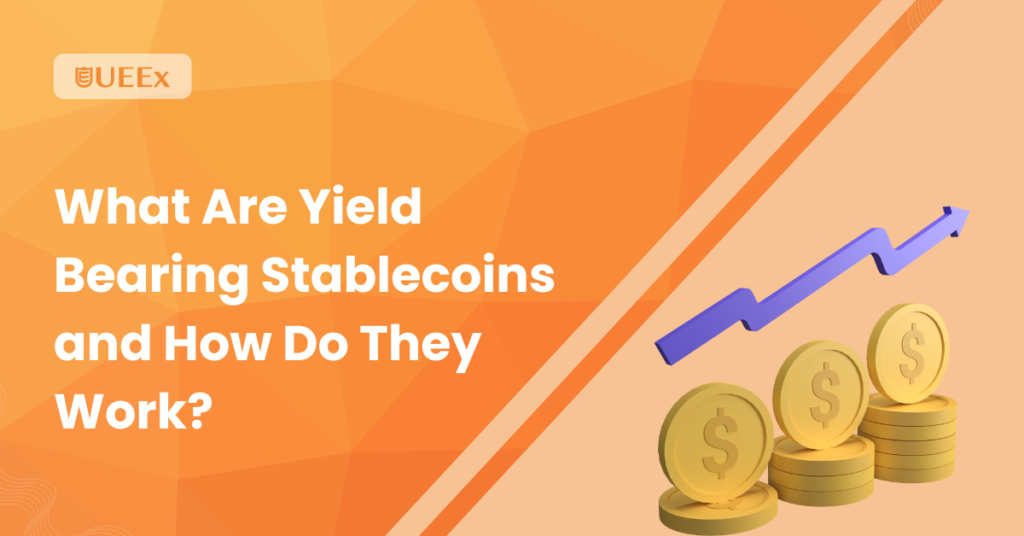
What if you could earn passive income while maintaining the stability of your crypto assets? Yield-bearing stable coins offer just that. These innovative digital assets combine the security of stablecoins assets pegged to stable values like the U.S. dollar with the opportunity to generate yield through mechanisms such as decentralized finance (DeFi) lending, staking, and real-world asset backing. In this article, we will examine how yield-bearing stable coins work, the various mechanisms used to generate yield, the benefits they offer to investors, and the potential risks involved. Whether you’re new to crypto or an experienced investor, you’ll learn popular yield-bearing stablecoins and the risk considerations to help you grow your portfolio without the market volatility typically seen in cryptocurrencies. Key Takeaways What Are Yield-Bearing Stablecoins? Yield-bearing stablecoins are a new type of cryptocurrency that combine the stability of traditional stablecoins with the ability to earn passive income. Think of them as digital dollars that not only hold their value but also generate interest over time. Unlike regular stablecoins like USDT or USDC, which maintain a 1:1 peg to the US dollar without offering any yield, yield-bearing stablecoins provide holders with returns simply by holding them in their wallets. These stablecoins achieve this by using various mechanisms such as decentralized finance (DeFi) lending, staking rewards, or backing by real-world assets like U.S. Treasury bills. For instance, USDe by Ethena Finance employs a delta-neutral strategy by holding cryptocurrencies like BTC, ETH, and SOL, while simultaneously shorting equal amounts of perpetual futures to earn yield from funding rates. Similarly, USDY by Ondo Finance derives its yield from short-term U.S. Treasuries and bank demand deposits. Yield-Bearing Stablecoins marketcap surges 225% since November 2024 How Yield-Bearing Stablecoins Differ from Traditional Stablecoins This section examines how yield-bearing stablecoins offer greater earning potential while maintaining the price stability of traditional stablecoins. 1. Yield Generation Traditional stablecoins like USDT, USDC, and DAI are designed to maintain a stable value, typically pegged to the US dollar, but they do not generate yield or interest for holders. They serve primarily as a stable medium of exchange or store of value within the cryptocurrency ecosystem. In contrast, yield-bearing stablecoins are designed to not only maintain a stable value but also generate passive income for holders. They achieve this by leveraging various mechanisms such as decentralized finance (DeFi) lending, staking rewards, or backing by real-world assets like U.S. Treasury bills. For example, USDe by Ethena Finance employs a delta-neutral strategy by holding cryptocurrencies like BTC, ETH, and SOL, while simultaneously shorting equal amounts of perpetual futures to earn yield from funding rates. Similarly, USDY by Ondo Finance derives its yield from short-term U.S. Treasuries and bank demand deposits, offering a more traditional investment approach within the crypto ecosystem. 2. Risk Profiles Traditional stablecoins are generally considered low-risk assets due to their backing by reserves and their widespread use in the crypto market. However, they are not immune to risks such as regulatory scrutiny, counterparty risk, and potential de-pegging events. Yield-bearing stablecoins introduce additional risks due to their reliance on yield-generating mechanisms. These risks include fluctuations in yield rates, exposure to DeFi protocol vulnerabilities, and potential regulatory challenges. For instance, the collapse of the TerraUSD (UST) algorithmic stablecoin in 2022 shows the risks associated with yield-bearing mechanisms that are not backed by real-world assets. Therefore, while yield-bearing stablecoins offer the potential for higher returns, they also come with increased risk profiles that investors should carefully consider. 3. Use Cases Traditional stablecoins are widely used in the crypto market for purposes such as trading, remittances, and as collateral in lending protocols. They provide a stable and liquid asset that facilitates transactions and financial activities within the digital asset space. Yield-bearing stablecoins, on the other hand, are primarily used by investors seeking to earn passive income while maintaining exposure to stable assets. They are utilized in DeFi protocols, staking platforms, and treasury management strategies to generate returns. For example, sDAI, a yield-bearing version of DAI, allows holders to earn interest through the Dai Savings Rate (DSR) within the MakerDAO protocol. This makes yield-bearing stablecoins attractive to users looking to maximize the utility of their holdings beyond mere price stability. 4. Regulatory Considerations Traditional stablecoins operate within a more established regulatory framework, particularly in jurisdictions like the United States and the European Union. They are subject to regulations that govern their issuance, reserve backing, and redemption processes, providing a level of oversight and consumer protection. Yield-bearing stablecoins, however, often operate in a more ambiguous regulatory environment. Their mechanisms for generating yield may not align with existing financial regulations, leading to potential legal and compliance challenges. For instance, the U.S. Securities and Exchange Commission (SEC) has indicated that certain yield-bearing stablecoins may be subject to securities laws, depending on their structure and the nature of their yield generation mechanisms. This regulatory uncertainty can impact the adoption and development of yield-bearing stablecoins. 5. Market Adoption and Liquidity Traditional stablecoins benefit from widespread adoption and liquidity across various cryptocurrency exchanges, DeFi platforms, and financial services. Their established presence in the market ensures that they are easily accessible and can be traded or utilized in numerous applications. Yield-bearing stablecoins, while gaining traction, have more limited adoption and liquidity. Their use is often confined to specific DeFi ecosystems or platforms that support their unique features. For example, yield-bearing stablecoins like sDAI are primarily used within the MakerDAO ecosystem, and their liquidity may be restricted to platforms that integrate with MakerDAO’s protocols. This limited adoption can affect the ease with which users can enter or exit positions in yield-bearing stablecoins. Benefits of Yield-Bearing Stablecoins In this section, we’ll look into the key benefits that make yield-bearing stablecoins an attractive option for many investors. 1. Earn Passive Income Yield-bearing stablecoins allow you to earn interest on your holdings without actively managing them. For instance, USDe by Ethena Finance generates yield through decentralized finance (DeFi) lending protocols like Aave and Compound. Similarly, USDY by Ondo Finance derives its yield from short-term U.S. Treasuries
How to Buy the Dip in Crypto: The Ultimate Guide
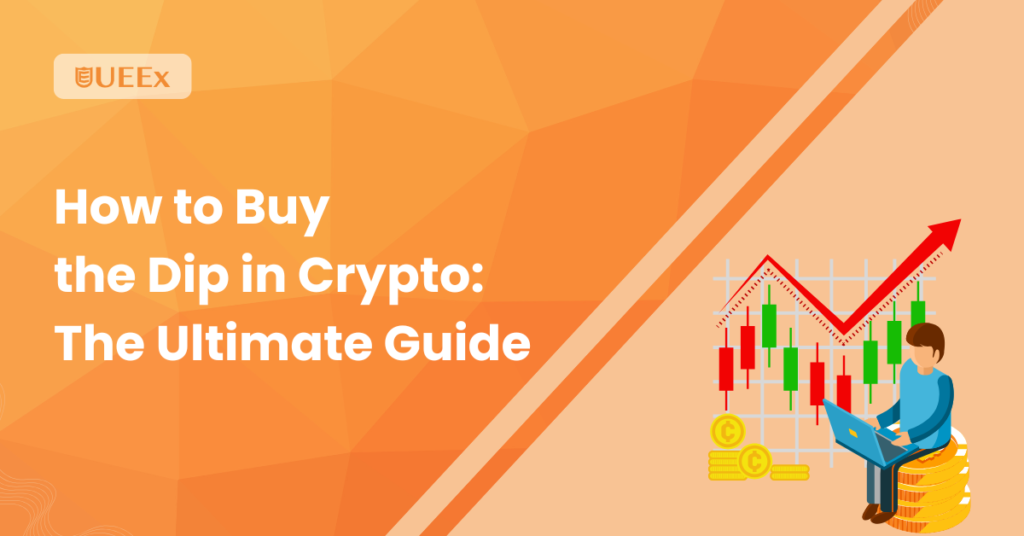
Cryptocurrency markets are known for their rapid swings, with prices often fluctuating dramatically within hours or even minutes. But is buying the dip a smart move? Whether you’re a seasoned investor or a newcomer, understanding when and how to enter the market during a price drop can make all the difference in your portfolio’s performance. In this article, we’ll walk you through the best strategies for buying the dip effectively, how to assess market conditions, and the risk management techniques that will help protect your investments while maximizing your opportunities. Key Takeaways What Does “Buy the Dip” Mean in Crypto? “Buying the dip” in crypto means purchasing a cryptocurrency after its price has dropped, with the expectation that it will rebound and increase in value over time. For instance, if Ethereum’s price falls from $3,000 to $2,500, a dip buyer might see this as an opportunity to acquire more ETH at a lower cost, anticipating a future price recovery. This strategy is based on the belief that market downturns are temporary and that the asset’s value will rise again, allowing investors to benefit from the rebound. Why Buying the Dip Is a Popular Strategy 1. It Offers a Chance to Buy at Lower Prices Buying the dip means you’re purchasing crypto when prices have fallen, allowing you to acquire assets at a discount. For example, if Ethereum drops from $3,000 to $2,500, buying during this dip means you get more ETH for your money. If the price rebounds, you stand to benefit from the increase. 2. It Aligns with Long-Term Investment Goals Many investors see dips as opportunities to accumulate assets they believe will grow over time. For instance, during market downturns, some investors continue to buy Bitcoin, anticipating its value will rise in the future. This approach supports a long-term investment strategy, focusing on potential future gains rather than short-term market fluctuations. 3. It Encourages a Disciplined Investment Approach Implementing strategies like dollar-cost averaging (DCA) during dips can promote disciplined investing. You reduce the impact of volatility and avoid the pitfalls of trying to time the market by investing a fixed amount regularly, regardless of price. This method can lead to more consistent investment outcomes over time. 4. It Helps Build Emotional Resilience Buying during market dips requires confidence and a steady mindset. Instead of reacting to fear and selling during downturns, you view these moments as opportunities. This perspective can help you stay calm during market volatility and make more rational investment decisions. 5. It Can Lead to Higher Returns if the Market Recovers If the market rebounded after a dip, those who bought at lower prices could see significant gains. For example, investors who purchased Bitcoin during its price drop in early 2020 saw substantial returns as the price surged later that year. While not guaranteed, buying the dip can position you to benefit from potential market recoveries. When Buying the Dip Works There are specific market conditions that make buying the dip a successful strategy, and recognizing them can lead to significant gains. 1. During a Temporary Price Correction in a Bull Market If a cryptocurrency is in a strong upward trend and experiences a short-term price drop, buying the dip can be advantageous. For example, in early 2020, Bitcoin’s price fell to around €3,700 due to global market uncertainties. Investors who bought during this dip saw significant gains as Bitcoin’s price rose to nearly €60,000 by the end of 2021. 2. When the Asset Has Strong Fundamentals Cryptocurrencies with solid technology, active development teams, and growing user adoption are more likely to recover after a dip. For instance, Ethereum has experienced multiple price drops but has often rebounded due to its strong ecosystem and widespread use in decentralized applications. 3. When Using Dollar-Cost Averaging (DCA) Implementing a DCA strategy by investing a fixed amount at regular intervals can mitigate the risk of market volatility. By purchasing more units when prices are low and fewer when prices are high, you can lower your average cost over time. 4. After Market Overreactions to News Sometimes, negative news causes a temporary market dip, even if the long-term outlook remains positive. For example, regulatory announcements can lead to short-term price declines, presenting buying opportunities if the fundamentals are unchanged. 5. When Technical Indicators Signal Oversold Conditions Technical analysis tools like the Relative Strength Index (RSI) can help identify oversold conditions. An RSI below 30 may indicate that a cryptocurrency is undervalued, suggesting a potential buying opportunity. When Buying the Dip Doesn’t Work While buying the dip can be a profitable strategy, there are times when it can lead to losses if not executed properly. 1. During a Prolonged Bear Market In extended downtrends, prices may continue to fall for a long time. For example, after peaking in November 2021, the total cryptocurrency market cap declined significantly, and many assets did not recover quickly. 2. When the Asset Lacks Strong Fundamentals Buying the dip in cryptocurrencies without solid fundamentals can be risky. If a project lacks a clear use case or active development, its price may not recover after a decline. 3. When External Factors Affect the Entire Market Macroeconomic events, such as interest rate hikes or geopolitical tensions, can lead to market-wide downturns. In such cases, individual cryptocurrencies may not rebound quickly, making dip-buying less effective. 4. When Relying Solely on Price Drops Without Research Buying a cryptocurrency just because its price has dropped, and without understanding the reasons behind the decline, can lead to losses. It’s essential to research the asset and market conditions before investing. 5. When Emotional Decisions Override Strategy Fear of missing out (FOMO) or panic selling can lead to impulsive decisions. Sticking to a well-thought-out investment plan is crucial, especially during volatile market conditions. What Causes Crypto Dips? Understanding why cryptocurrency prices dip is essential for making informed investment decisions. Let’s explore five common reasons behind these market downturns. 1. Profit-Taking by Investors After significant price increases, some investors choose
How to Trade Futures: A Beginner’s Guide to Futures Trading
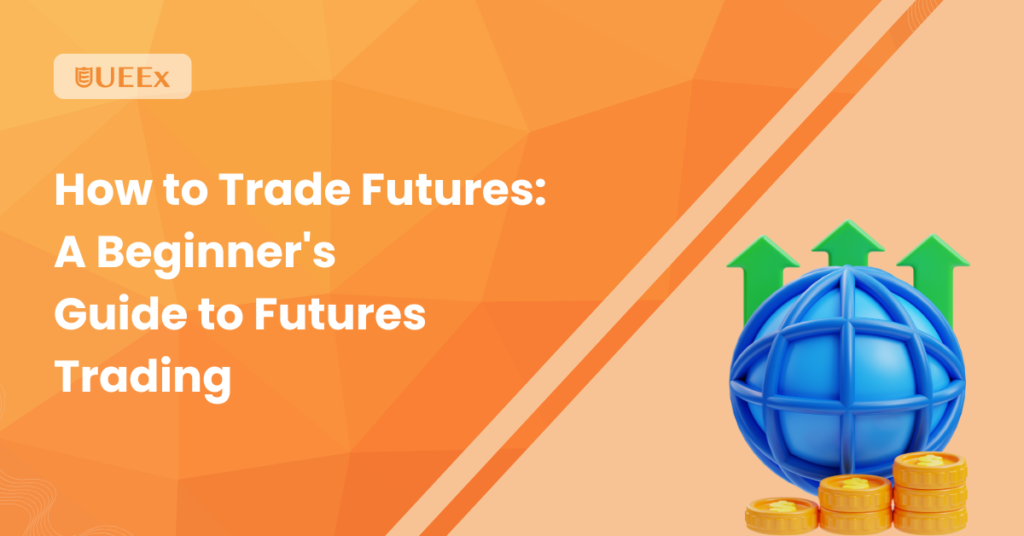
It’s too complex to understand; you’ll be easily liquidated. These are some of the words you’ve probably heard when someone talks about futures trading. Well, here’s the good news—futures trading is not as intimidating as it’s often made out to be. With the right knowledge and tools, you can learn how to trade futures confidently, manage your risks, and take advantage of real market opportunities. If you’re just starting your trading journey or you’re already trading but don’t fully understand how futures work, you’re in the right place. This guide will walk you through everything you need to know to start trading futures with purpose and precision. Key Takeaways What Is Futures Trading? Source: Freepik Futures trading involves buying and selling contracts that obligate the buyer to purchase, or the seller to sell, an underlying asset at a predetermined price and date in the future. These contracts are standardized agreements, traded on futures exchanges, and can represent a variety of assets such as commodities, stocks, or even financial instruments. Unlike traditional investing, where you purchase the asset itself, futures trading allows you to speculate on the price movement of an asset without owning it. This means you can profit from both rising and falling markets. For example, if you believe the price of crude oil will rise, you can buy a futures contract. If the price does go up, you can sell the contract at a profit. On the flip side, if you expect a drop in prices, you can sell a futures contract and repurchase it later at a lower cost. Traders use futures contracts to speculate, while businesses use them to hedge against market price fluctuations. Whether you’re a farmer wanting to lock in a price for your crops or a trader seeking to profit from market fluctuations, futures trading provides powerful opportunities to manage risk and earn profits. How Futures Trading Works Futures trading works by allowing traders to speculate on the future price of an asset using standardized contracts that are bought and sold on regulated exchanges. These contracts represent an agreement to buy or sell a specific quantity of an underlying asset, such as crude oil, gold, wheat, or a financial index, at a predetermined price on a specified date. Each futures contract includes key details such as the contract size, expiration date, and settlement terms. The standardization of these contracts by exchanges ensures transparency, ease of trading, and consistency across the market. Clearing houses play a critical role in this system by handling settlements and managing counterparty risk, ensuring both sides of a trade are fulfilled even if one party defaults. Futures contracts span a wide range of markets: Here’s how futures trading typically works: In futures trading, timing, strategy, and risk management are key. Due to the leverage involved, even slight price movements can result in substantial gains or losses. Understanding how futures trading works is essential before placing your first trade. Step-By-Step Guide on How to Trade Futures Now that you know how futures trading works, it’s time to walk through the process of trading futures step by step. Here is a detailed breakdown of each step: Choose a Futures Market to Trade The first step is deciding which futures market you want to trade. Futures contracts exist for a wide variety of assets, and each market behaves differently depending on the underlying asset, as mentioned above. For example, if you’re confident that crude oil prices will rise due to seasonal demand or geopolitical tensions, you could trade WTI Crude Oil futures. A valuable tip to keep in mind is to stick to liquid markets (those with high trading volumes) if you’re new to trading. They offer tighter spreads and easier order execution. Research and Form a Market Outlook Before placing a trade, conduct both technical and fundamental analysis. This helps you form a reasoned opinion about where the market is headed. Let’s say US inflation is rising rapidly; you may forecast that gold prices, a traditional hedge against inflation, will increase. This is where you decide: Do you want to go long (buy) or short (sell)? Open a Futures Trading Account To start trading futures, you’ll need to open an account with a futures-licensed broker. This is different from a regular stock trading account. What you’ll need: Popular platforms include: Ensure your chosen platform provides access to the markets and tools you require, including charting, margin reports, and other relevant features. Understand Margin and Leverage Futures contracts are leveraged instruments, meaning you don’t pay the full value upfront. Instead, you post an initial margin — a small percentage of the contract value. Let’s say a crude oil contract, for example, controls 1,000 barrels and trades at $75 per barrel, so the total value is $75,000. However, you may only need a margin of $6,000 to control this contract. This gives you significant exposure, but also increases risk. Choose Your Contract and Expiration Month Each futures contract has an expiration month. You must select the month for trading. Short-term traders usually pick the nearest contract month for higher liquidity. Hedgers or longer-term traders may use later expirations. Be aware of rollover periods—when traders shift their positions from expiring contracts to the next month, which can lead to temporary volatility. Place Your Trade Once you’ve selected the market, contract, and direction, it’s time to place your trade. You’ll need to choose the number of contracts and an order type, which includes: Set Stops and Profit Targets Proper risk management starts here. Use: Monitor and Manage Your Trade After entering a trade, keep an eye on: Sometimes, it’s better to adjust your stop-loss or close a position early if conditions change. Most trading platforms offer real-time alerts and mobile access, allowing you to manage trades on the go. Close or Let the Contract Settle You can exit your position at any time before the contract expires. This is usually done by placing an opposite order. Closing Examples: If you don’t manually close your
What Is a Block Trade and How Does It Work?
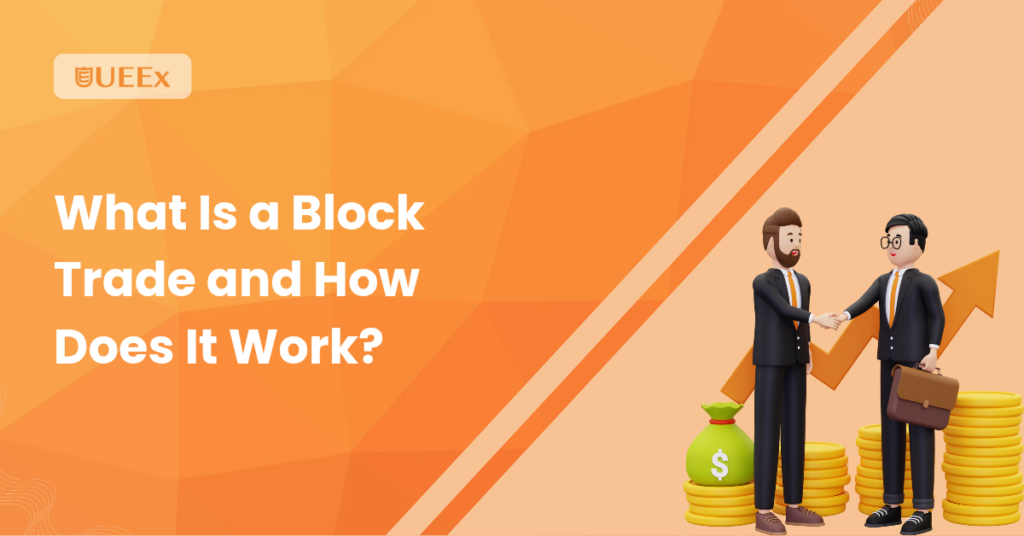
So, here’s the thing — imagine a massive investor wants to sell millions of dollars’ worth of shares. If they dump it all on the open market at once, prices could crash instantly. Instead, they execute what’s known as a block trade — a large, privately negotiated deal between two parties, often handled through a broker or specialized trading platform. These trades are carefully structured to minimize market disruption and keep details confidential until after execution. Typically used by institutional investors and accredited entities, block trades are a quiet but powerful force behind many major market moves. You may still be wondering; these are all technical terms. This blog post breaks down exactly what a block trade is, how it works, and why it plays a critical role in modern markets. Key Takeaways What Is a Block Trade? Source: Ideogram A block trade is a large-volume transaction of securities (stocks, bonds, or derivatives) or cryptocurrencies executed off the open market to minimize market disruption. These trades typically involve a significant number of shares or bonds, often exceeding 10,000 shares of stock or $200,000 worth of bonds, and are conducted by institutional investors such as mutual funds, hedge funds, or high-net-worth individuals. Unlike regular trades on public exchanges, block trades are arranged off-exchange through investment banks or broker-dealers. This allows the buyer and seller to agree on a price in advance without influencing market prices through visible, large-volume orders. For example, if a hedge fund wants to sell 50,000 shares of Apple (AAPL) at 180 per share (9M total). Instead of dumping all shares on the NASDAQ (which could crash the price), it negotiates a block trade with another institution via a broker-dealer. The trade settles at an agreed price without affecting the public market. How Does a Block Trade Work? Source: Freepik Here’s a breakdown of how a block trade works: Initiating the Block Trade The process begins when an investor (usually an institutional investor such as a mutual fund, hedge fund, or pension fund) decides to buy or sell a significant amount of a security. The transaction size usually exceeds a certain threshold, typically 10,000 shares or $200,000 in bonds. For example, a pension fund may want to sell 500,000 company shares without causing the price to drop. This could be to rebalance the portfolio or liquidate assets. Finding a Counterparty Once the decision to execute a block trade is made, the buyer or seller contacts a broker-dealer, who helps facilitate the transaction by finding a counterparty. The counterparty is usually another institutional investor or a large hedge fund. The broker-dealer works behind the scenes to find a willing buyer or seller. Here, the role of investment banks and institutional traders becomes crucial. Investment banks can provide access to large networks of institutional clients and facilitate private negotiations. They have the necessary market intelligence and infrastructure to execute large trades without attracting undue attention. Negotiating the Price Once both parties are identified, they negotiate the price of the asset being traded. This is typically done off-market to avoid influencing the security’s current market price. The negotiated price may be close to the current market price, but it also accounts for factors like liquidity and the size of the transaction. The buyer and seller often agree on the price with the help of a broker-dealer, who acts as the intermediary. In many cases, the broker-dealer will act as a market maker to match buyers and sellers, ensuring the price remains stable and both parties are satisfied. Choosing the Execution Platform Block trades are typically executed off-exchange to avoid price disruptions in the open market. There are several execution platforms used for this process: Over-the-Counter (OTC) OTC trading refers to transactions directly between the buyer and seller, typically via a broker-dealer. The trade is privately negotiated in OTC markets, and the terms are not disclosed to the public. Dark Pools A dark pool is a private exchange or forum for trading securities where the trade details, such as price and quantity, are hidden from the public until the transaction is completed. These pools allow institutional investors to execute large trades without revealing their intentions to the market. Private Negotiations Sometimes, block trades are negotiated directly between buyers and sellers. These private negotiations are done off-market, meaning they do not appear on public order books or exchanges, ensuring the transaction is confidential. Executing the Trade Once a price is agreed upon, the trade is executed. In many cases, the broker-dealer will handle the logistics of settling the trade, ensuring that the shares or securities are exchanged smoothly between the buyer and the seller. The actual execution typically happens quickly, but the details remain hidden until the trade is completed. Post-Trade Transparency After the block trade is completed, the transaction details are reported to the relevant market regulators, but only after a delay. This ensures that the transaction does not influence the market price during the execution process. For instance, in the case of U.S. equities, block trades are typically reported to FINRA (Financial Industry Regulatory Authority) after the transaction is completed. While the transaction details are eventually made public, the buyer and seller benefit from the trade’s private nature during execution. This minimizes the potential for information leakage that could negatively affect the security’s price. Clearing and Settlement Finally, like any other trade, a block trade undergoes a clearing and settlement process. The clearinghouse acts as an intermediary between the buyer and seller, ensuring that the trade is settled and that the correct shares or securities are delivered to the buyer in exchange for payment. This process can take one or more days, depending on the nature of the asset being traded. Parties involved in a Block Trade are: Buyer and Seller These are typically institutional investors who wish to execute a large transaction, such as pension funds, hedge funds, or mutual funds. Due to the large volume involved, individual investors rarely engage in block trades. Broker-Dealer Broker-dealers are the

